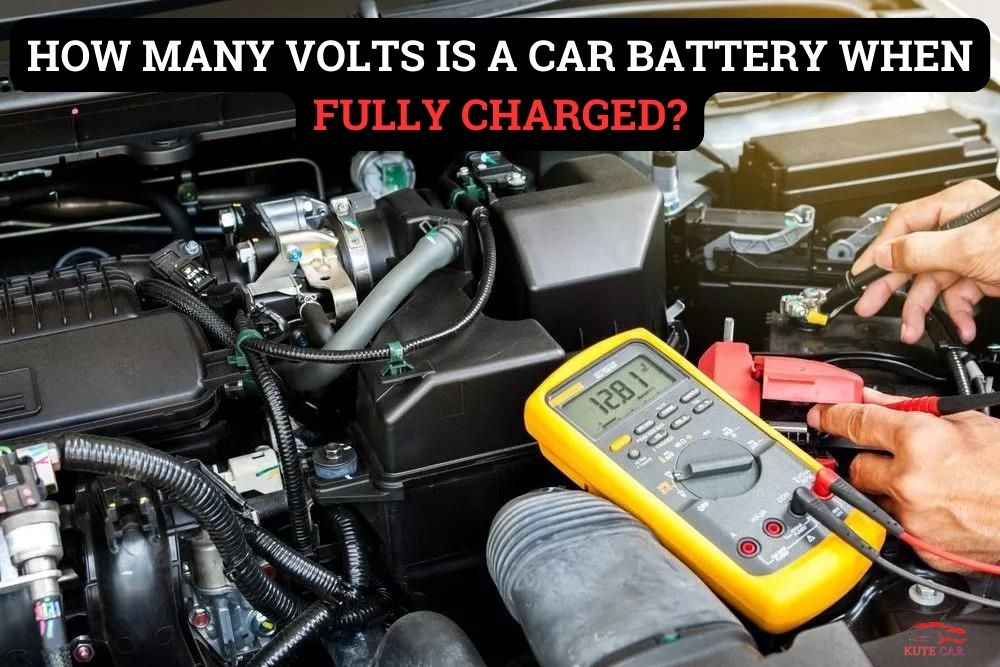How many volts is a car battery when fully charged? A vehicle battery is a battery-fueled battery that controls a vehicle’s starter motor, beginning framework, and other frivolity frameworks. When fully stimulated, a typical automotive lead-disaster battery will have a voltage of approximately 12.6 volts. Notwithstanding, the genuine voltage can vary depending on the battery’s age, type, temperature, and charge state.
How a Car Battery Works
A vehicle battery comprises many lead-corrosive cells connected in series to produce a 12-volt nominal voltage. Each cell conveys about 2 volts, so six 2-volt cells are combined to shape a 12-volt battery. A progression of positive and adverse lead plates are lowered in a sulfuric corrosive and water-electrolyte arrangement inside every cell.
At the point when the battery is giving current, a compound response happens inside the lead plates. Lead combines with the sulfuric acid in the electrolyte to produce electrons and form lead sulfate on the leaves. These electrons give the electric flow to drive the vehicle’s electrical framework. As the battery releases, the lead plates become progressively covered with lead sulfate.

During charging, the substance response is switched. The lead sulfate changes once more into lead and sulfuric corrosive. This connection allows the battery to recover its electrical cutoff and back a voltage.
Voltage Depends on State of Charge
The voltage delivered by a vehicle battery straightforwardly relates to its charge condition. As the battery releases and loses its control, the voltage drops. When completely energized, a 12-volt battery will have a voltage of something like 12.6 volts.
This is because lead-destructive batteries produce around 2.1 volts per cell when totally empowered, to some degree higher than the apparent 2 volts.
Here are the run-of-the-mill voltage readings at various charge levels:
- 12.6 to 12.8 volts = 100% fully charged
- 12.4 volts = 75% charged
- 12.2 volts = 50% charged
- 12.0 volts = 25% charged
- 11.9 volts or less = Deficient charge, needs recharging
Assuming the voltage dips under around 11.8 to 11.9 volts, this commonly implies the battery is totally released and undoubtedly won’t begin the vehicle. The genuine voltage expected for making might change in light of the battery’s state and the amperage (cold turning amps) required by the car. Exceptionally old or powerless batteries may not dependably start if under 12 volts.
As a guideline, a wholly energized sound battery should quantify 12.6 volts or higher when the vehicle is switched off. Assuming it estimates lower, the battery should be re-energized to reach its full voltage.
Factors that Affect Voltage
A car battery’s voltage reading can be affected by more than just the charge level:

- Temperature – Cold temperatures diminish battery voltage. In exceptionally warm or chilly climates, the voltage readings should be changed up or somewhere near a couple of tenths of a volt.
- Age and Wear – More established batteries have lower voltage readings than new batteries at a similar charge condition. The lead plates corrupt after some time.
- Parasitic Drain – Electrical embellishments running while the vehicle is off-channel the battery after some time diminish the voltage.
- Battery Type – Different lead-corrosive battery plans produce marginally various voltages. For instance, an upkeep-free ingested glass mat (AGM) battery will quantify moderately higher than an overflowed cell battery.
- Charging System Issues – Issues with the alternator or voltage controller can cause unusual voltage readings that are not intelligent of the genuine condition of the charge.
- Bad Cell – One shorted or harmed cell in the battery pack can reduce the general voltage.
So, the genuine voltage estimation of a vehicle battery will change to some degree in light of these elements. For most purposes, 12.6V can be utilized as the benchmark for a completely energized 12V lead-corrosive car battery under ordinary circumstances.
Maintaining Proper Voltage to Prolong Battery Life
To expand the life expectancy of a vehicle battery, keeping a complete condition of charge and legitimate voltage is significant. Battery life will be significantly reduced by performing frequent deep discharge cycles and allowing the voltage to drop too low.
To maintain optimal voltage, here are some battery care recommendations:
- Re-energize the battery immediately if it becomes released because of extras running while left or, on the other hand, assuming that the vehicle sits unused for quite a long time. Never permit the battery to remain totally drained.
- Utilize a battery delicate or stream charger when the car won’t be driven significantly to keep the battery at top voltage.
- Keep away from exorbitantly profound release cycles. Try not to deplete the battery beneath half charge if conceivable.
Essential tips for keeping my car battery voltage happy
- Regular Maintenance
- Secure Connections
- Proper Charging
- Temperature Considerations
- Minimize Electrical Load
- Regular Driving
- Battery Insulation
- Voltage Checks
- Emergency Kit
- Professional Inspection
Conclusion
In summary, when estimated in an open circuit with the motor off, a wholly energized 12-volt lead-corrosive vehicle battery will have a voltage of around 12.6-12.8 volts. This voltage level shows every one of the six 2-volt cells in the battery is at its most outstanding limit. As the battery releases with use, the voltage continuously lowers until it stretches around 11.8-11.9 volts when totally dead. While the condition of charge is the essential component influencing voltage, different elements like temperature, age, and harm can likewise affect the perusing.
FAQs Regarding : How Many Volts is a Car Battery When Fully charged?
Q1: How many volts does a car battery have when fully charged?
A fully charged car battery should hover around 12.6 volts.
Q2: Are there different types of car batteries with different voltages?
There are deviations like 6-volt and 24-volt batteries for specific cars. Always check your car’s manual before assuming!
Q3: How does temperature affect the voltage of a car battery?
Generally, higher temperatures can increase voltage, while lower temperatures may result in a temporary voltage drop.




